On the Crush Behavior and Energy Absorption of Sustainable Beverage Cans and Their Polyurethane Foam-Filled Structures: An Experimental Study
Abstract
:1. Introduction
2. Materials and Methods
2.1. Specimens
2.2. Experimental Methods
2.3. Material Properties
3. Results and Discussion
3.1. Crushing Behavior of Empty Beverage Cans
3.2. Crushing Behavior of Foam-Filled Cans
3.3. Energy Absorption of Beverage Cans
3.3.1. Crashworthiness Indicators
3.3.2. Energy Absorption in Axial Compression
3.4. Interaction Effects of Foam Filling
4. Conclusions
- (1).
- The EA modes of all five types of empty beverage cans are classified as Type II. The primary failure mode is local buckling, with the location of buckling being influenced by the size parameters of the cans. The deformation modes of empty beverage cans have important effects on the manufacturing and use process. The EA performance of beverage cans with local defects will be significantly reduced.
- (2).
- Filling cans with polyurethane foam changes the deformation mode of a structure. As the foam density increases, the deformation mode of smaller-sized beverage cans changes from diamond mode to concertina mode, while larger-sized beverage cans are gradually deformed by the polyurethane foam. The deformation mode approaches Euler bending.
- (3).
- Compared to empty beverage cans, adding polyurethane foam shifts the EA from solely Type II to a combination of Type I and II, enhancing overall crashworthiness metrics such as EA, SEA, PCF, MCF, and CFE. Across all five can types, EA rises with higher foam density, and SEA generally trends upward as well.
- (4).
- There is a coupled energy-absorbing phenomenon between the foam filling and the can body, as evidenced by the increased EA capacity of foam-filled cans compared to the cumulative EA of the individual components. As the filling density increases from 100 kg/m3 to 140 kg/m3, there is a corresponding increase in the proportion of energy absorbed by the interaction effects.
- (5).
- FFC-5-140 exhibits the highest EA among the five types of FFCs, whereas FFC-1-100 demonstrates the best SEA. The larger EBC-5 can is capable of absorbing more energy, while the EBC-1 can, with a smaller aspect ratio, shows advantages in SEA when filled with polyurethane compared to other structures.
Supplementary Materials
Author Contributions
Funding
Institutional Review Board Statement
Informed Consent Statement
Data Availability Statement
Conflicts of Interest
References
- Alexander, J.M. An approximate analysis of the collapse of thin cylindrical shells under axial loading. Q. J. Mech. Appl. Math. 1960, 13, 10–15. [Google Scholar] [CrossRef]
- Andrews, K.R.F.; England, G.L.; Ghani, E. Classification of the Axial Collapse of Cylindrical Tubes under Quasi-Static Loading. Int. J. Mech. Sci. 1983, 25, 687–696. [Google Scholar] [CrossRef]
- Abramowicz, W.; Jones, N. Dynamic Progressive Buckling of Circular and Square Tubes. Int. J. Impact Eng. 1986, 4, 243–270. [Google Scholar] [CrossRef]
- Ren, X.; Han, D.; Sun, L.; Zhang, X.G.; Jiang, W.; Tao, Z.; Xie, Y.M.; Yang, F.; Lu, G.X. Experimental and Numerical Investigations of Aluminum Foam-Filled Auxetic Circular Tubular Metamaterials with Elliptical Cells. Constr. Build. Mater. 2023, 374, 130900. [Google Scholar] [CrossRef]
- Peng, Y.; Li, T.; Bao, C.; Zhang, J.; Xie, G.; Zhang, H. Performance Analysis and Multi-Objective Optimization of Bionic Dendritic Furcal Energy-Absorbing Structures for Trains. Int. J. Mech. Sci. 2023, 246, 108145. [Google Scholar] [CrossRef]
- Yu, Z.; Amdahl, J. A Review of Structural Responses and Design of Offshore Tubular Structures Subjected to Ship Impacts. Ocean Eng. 2018, 154, 177–203. [Google Scholar] [CrossRef]
- Zhu, G.; Sun, G.; Yu, H.; Li, S.; Li, Q. Energy Absorption of Metal, Composite and Metal/Composite Hybrid Structures under Oblique Crushing Loading. Int. J. Mech. Sci. 2018, 135, 458–483. [Google Scholar] [CrossRef]
- Sommer, D.E.; Thomson, D.; Falcó, O.; Quino, G.; Cui, H.; Petrinic, N. Damage Modelling of Carbon Fibre Composite Crush Tubes: Numerical Simulation and Experimental Validation of Drop Weight Impact. Compos. Part Appl. Sci. Manuf. 2022, 160, 107033. [Google Scholar] [CrossRef]
- Mamalis, A.G.; Manolakos, D.E.; Ioannidis, M.B.; Papapostolou, D.P. On the Response of Thin-Walled CFRP Composite Tubular Components Subjected to Static and Dynamic Axial Compressive Loading: Experimental. Compos. Struct. 2005, 69, 407–420. [Google Scholar] [CrossRef]
- Siromani, D.; Awerbuch, J.; Tan, T.-M. Finite Element Modeling of the Crushing Behavior of Thin-Walled CFRP Tubes under Axial Compression. Compos. Part B Eng. 2014, 64, 50–58. [Google Scholar] [CrossRef]
- Changfang, Z.; Heow Pueh, L.; Kheng Lim, G.; Jianlin, Z.; Kebin, Z.; Zhendong, Z.; Jie, R.; Guigao, L. Preparation Process and Compression Mechanics of Carbon Fiber Reinforced Plastics Negative Poisson’s Ratio Structure (CFRP + NPRS). Compos. Struct. 2022, 292, 115667. [Google Scholar] [CrossRef]
- Zhang, Z.; Liu, Q.; Fu, J.; Lu, Y. Parametric Study on the Crashworthiness of the Al/CFRP/GFRP Hybrid Tubes under Quasi-Static Crushing. Thin-Walled Struct. 2023, 192, 111156. [Google Scholar] [CrossRef]
- Li, H.; Ding, Y.; Li, J.; Li, Z.; Wang, J.; Wu, C.; Xiang, J.; Tao, J. The Effect of Different Interface Conditions on the Energy Absorption Characteristics of Al/CFPP Hybrid Tube. Thin-Walled Struct. 2023, 185, 110578. [Google Scholar] [CrossRef]
- Yang, H.; Ren, Y. Crashworthiness Design of CFRP/AL Hybrid Circular Tube under Lateral Crushing. Thin-Walled Struct. 2023, 186, 110669. [Google Scholar] [CrossRef]
- Guillow, S.R.; Lu, G.; Grzebieta, R.H. Quasi-Static Axial Compression of Thin-Walled Circular Aluminium Tubes. Int. J. Mech. Sci. 2001, 43, 2103–2123. [Google Scholar] [CrossRef]
- Mamalis, A.G.; Manolakos, D.E.; Ioannidis, M.B.; Papapostolou, D.P. The Static and Dynamic Axial Collapse of CFRP Square Tubes: Finite Element Modelling. Compos. Struct. 2006, 74, 213–225. [Google Scholar] [CrossRef]
- Fan, Z.; Lu, G.; Liu, K. Quasi-Static Axial Compression of Thin-Walled Tubes with Different Cross-Sectional Shapes. Eng. Struct. 2013, 55, 80–89. [Google Scholar] [CrossRef]
- Sun, J.; He, Y.; Zhang, X.; Li, X.; Lu, M.; Chen, Y. Energy Absorption and Topology Optimization of Self-Similar Inspired Multi-Cell Square Tubes. Thin-Walled Struct. 2024, 196, 111491. [Google Scholar] [CrossRef]
- Abada, M.; Ibrahim, A. Hybrid Multi-Cell Thin-Walled Tubes for Energy Absorption Applications: Blast Shielding and Crashworthiness. Compos. Part B Eng. 2020, 183, 107720. [Google Scholar] [CrossRef]
- Ha, N.S.; Pham, T.M.; Chen, W.; Hao, H. Energy Absorption Characteristics of Bio-Inspired Hierarchical Multi-Cell Bi-Tubular Tubes. Int. J. Mech. Sci. 2023, 251, 108260. [Google Scholar] [CrossRef]
- Gao, Z.; Wang, H.; Sun, H.; Sun, T.; Wu, Y.; Leung, C.L.A.; Wang, H. Additively Manufactured High-Energy-Absorption Metamaterials with Artificially Engineered Distribution of Bio-Inspired Hierarchical Microstructures. Compos. Part B Eng. 2022, 247, 110345. [Google Scholar] [CrossRef]
- Wang, P.; Yang, F.; Li, P.; Zhang, W.; Lu, G.; Fan, H. Bio-Inspired Vertex Modified Lattice with Enhanced Mechanical Properties. Int. J. Mech. Sci. 2023, 244, 108081. [Google Scholar] [CrossRef]
- Hussein, R.D.; Ruan, D.; Lu, G.; Sbarski, I. Axial Crushing Behaviour of Honeycomb-Filled Square Carbon Fibre Reinforced Plastic (CFRP) Tubes. Compos. Struct. 2016, 140, 166–179. [Google Scholar] [CrossRef]
- Liu, Q.; Xu, X.; Ma, J.; Wang, J.; Shi, Y.; Hui, D. Lateral Crushing and Bending Responses of CFRP Square Tube Filled with Aluminum Honeycomb. Compos. Part B Eng. 2017, 118, 104–115. [Google Scholar] [CrossRef]
- Zhang, Z.; Sun, W.; Zhao, Y.; Hou, S. Crashworthiness of Different Composite Tubes by Experiments and Simulations. Compos. Part B Eng. 2018, 143, 86–95. [Google Scholar] [CrossRef]
- Yi, Z.; Si-yuan, H.; Jia-gui, L.; Wei, Z.; Xiao-lu, G.; Jin, Y. Density Gradient Tailoring of Aluminum Foam-Filled Tube. Compos. Struct. 2019, 220, 451–459. [Google Scholar] [CrossRef]
- Li, D.; Qin, R.; Xu, J.; Zhou, J.; Chen, B. Topology Optimization of Thin-Walled Tubes Filled with Lattice Structures. Int. J. Mech. Sci. 2022, 227, 107457. [Google Scholar] [CrossRef]
- Cetin, E.; Baykasoğlu, C. Energy Absorption of Thin-Walled Tubes Enhanced by Lattice Structures. Int. J. Mech. Sci. 2019, 157–158, 471–484. [Google Scholar] [CrossRef]
- Simpson, J.; Kazancı, Z. Crushing Investigation of Crash Boxes Filled with Honeycomb and Re-Entrant (Auxetic) Lattices. Thin-Walled Struct. 2020, 150, 106676. [Google Scholar] [CrossRef]
- Sun, G.; Li, S.; Liu, Q.; Li, G.; Li, Q. Experimental Study on Crashworthiness of Empty/Aluminum Foam/Honeycomb-Filled CFRP Tubes. Compos. Struct. 2016, 152, 969–993. [Google Scholar] [CrossRef]
- Xie, S.; Zhang, J.; Liu, X.; Zheng, S.; Liu, Z. A Reinforced Energy-Absorbing Structure Formed by Combining Multiple Aluminum Foam-Filled Open-Hole Tubes. Int. J. Mech. Sci. 2022, 224, 107319. [Google Scholar] [CrossRef]
- Zhao, C.; Goh, K.L.; Lee, H.P.; Yin, C.; Zhang, K.; Zhong, J. Experimental Study and Finite Element Analysis on Energy Absorption of Carbon Fiber Reinforced Composite Auxetic Structures Filled with Aluminum Foam. Compos. Struct. 2023, 303, 116319. [Google Scholar] [CrossRef]
- Hussein, R.D.; Ruan, D.; Lu, G.; Guillow, S.; Yoon, J.W. Crushing Response of Square Aluminium Tubes Filled with Polyurethane Foam and Aluminium Honeycomb. Thin-Walled Struct. 2017, 110, 140–154. [Google Scholar] [CrossRef]
- Paquette, J.A.; Kyriakides, S. Plastic Buckling of Tubes under Axial Compression and Internal Pressure. Int. J. Mech. Sci. 2006, 48, 855–867. [Google Scholar] [CrossRef]
- Zhang, X.W.; Yu, T.X. Energy Absorption of Pressurized Thin-Walled Circular Tubes under Axial Crushing. Int. J. Mech. Sci. 2009, 51, 335–349. [Google Scholar] [CrossRef]
- Magliaro, J.; Altenhof, W.; Alpas, A.T. A Review of Advanced Materials, Structures and Deformation Modes for Adaptive Energy Dissipation and Structural Crashworthiness. Thin-Walled Struct. 2022, 180, 109808. [Google Scholar] [CrossRef]
- Malinauskaite, J.; Jouhara, H.; Czajczyńska, D.; Stanchev, P.; Katsou, E.; Rostkowski, P.; Thorne, R.J.; Colón, J.; Ponsá, S.; Al-Mansour, F.; et al. Municipal Solid Waste Management and Waste-to-Energy in the Context of a Circular Economy and Energy Recycling in Europe. Energy 2017, 141, 2013–2044. [Google Scholar] [CrossRef]
- Ragaert, K.; Delva, L.; Van Geem, K. Mechanical and Chemical Recycling of Solid Plastic Waste. Waste Manag. 2017, 69, 24–58. [Google Scholar] [CrossRef] [PubMed]
- Nanda, S.; Berruti, F. Municipal Solid Waste Management and Landfilling Technologies: A Review. Environ. Chem. Lett. 2021, 19, 1433–1456. [Google Scholar] [CrossRef]
- Deshwal, G.K.; Panjagari, N.R. Review on Metal Packaging: Materials, Forms, Food Applications, Safety and Recyclability. J. Food Sci. Technol. 2020, 57, 2377–2392. [Google Scholar] [CrossRef]
- Bao, S.; Eggen, S.; Syvertsen, M.; Kvithyld, A. Collection, Thermal Treatment, and Remelting End-of-Life Al Packaging in Norway. JOM 2023, 75, 5755–5763. [Google Scholar] [CrossRef]
- Stotz, P.M.; Niero, M.; Bey, N.; Paraskevas, D. Environmental Screening of Novel Technologies to Increase Material Circularity: A Case Study on Aluminium Cans. Resour. Conserv. Recycl. 2017, 127, 96–106. [Google Scholar] [CrossRef]
- Palanivelu, S.; Van Paepegem, W.; Degrieck, J.; Reymen, B.; Ndambi, J.-M.; Vantomme, J.; Kakogiannis, D.; Wastiels, J.; Van Hemelrijck, D. Close-Range Blast Loading on Empty Recyclable Metal Beverage Cans for Use in Sacrificial Cladding Structure. Eng. Struct. 2011, 33, 1966–1987. [Google Scholar] [CrossRef]
- Palanivelu, S.; Van Paepegem, W.; Degrieck, J.; De Pauw, S.; Vantomme, J.; Wastiels, J.; Kakogiannis, D.; Van Hemelrijck, D. Low Velocity Axial Impact Crushing Performance of Empty Recyclable Metal Beverage Cans. Int. J. Impact Eng. 2011, 38, 622–636. [Google Scholar] [CrossRef]
- Ashrafi, M.; Woodsum, C.J.; Papadopoulos, J.; Hamouda, A.S.; Nayeb-Hashemi, H.; Vaziri, A. In Situ Strengthening of Thin-Wall Structures Using Pressurized Foam. Constr. Build. Mater. 2015, 100, 298–304. [Google Scholar] [CrossRef]
- Liu, C.; Qi, G.; Li, P. Crashworthy Characteristics of Sustainable Thin-Walled Tubes: A Study on Recycled Beverage Cans. Mech. Adv. Mater. Struct. 2022, 29, 3222–3236. [Google Scholar] [CrossRef]
- Chen, J.; Li, E.; Liu, W.; Mao, Y.; Hou, S. Sustainable Composites with Ultrahigh Energy Absorption from Beverage Cans and Polyurethane Foam. Compos. Sci. Technol. 2023, 239, 110047. [Google Scholar] [CrossRef]
- Martins, A.L.; Couto, A.A.; Lima, N.B. Study of the Deep Drawing Behavior and Crystallographic Texture of AA 3104-H19 Aluminum Alloy Sheets. Proc. Inst. Mech. Eng. Part J. Mater. Des. Appl. 2016, 230, 748–759. [Google Scholar] [CrossRef]
- Gupta, N.K. Nagesh Collapse Mode Transitions of Thin Tubes with Wall Thickness, End Condition and Shape Eccentricity. Int. J. Mech. Sci. 2006, 48, 210–223. [Google Scholar] [CrossRef]
- Calladine, C.R.; English, R.W. Strain-Rate and Inertia Effects in the Collapse of Two Types of Energy-Absorbing Structure. Int. J. Mech. Sci. 1984, 26, 689–701. [Google Scholar] [CrossRef]
- Xiang, Y.; Wang, M.; Yu, T.; Yang, L. Key Performance Indicators of Tubes and Foam-Filled Tubes Used as Energy Absorbers. Int. J. Appl. Mech. 2015, 7, 1550060. [Google Scholar] [CrossRef]
- Ousji, H.; Belkassem, B.; Pyl, L.; Vantomme, J. Air-Blast Loading on Empty Metallic Beverage Can Used as Sacrificial Cladding: Experimental, Analytical and Numerical Study. Eng. Struct. 2020, 204, 109979. [Google Scholar] [CrossRef]

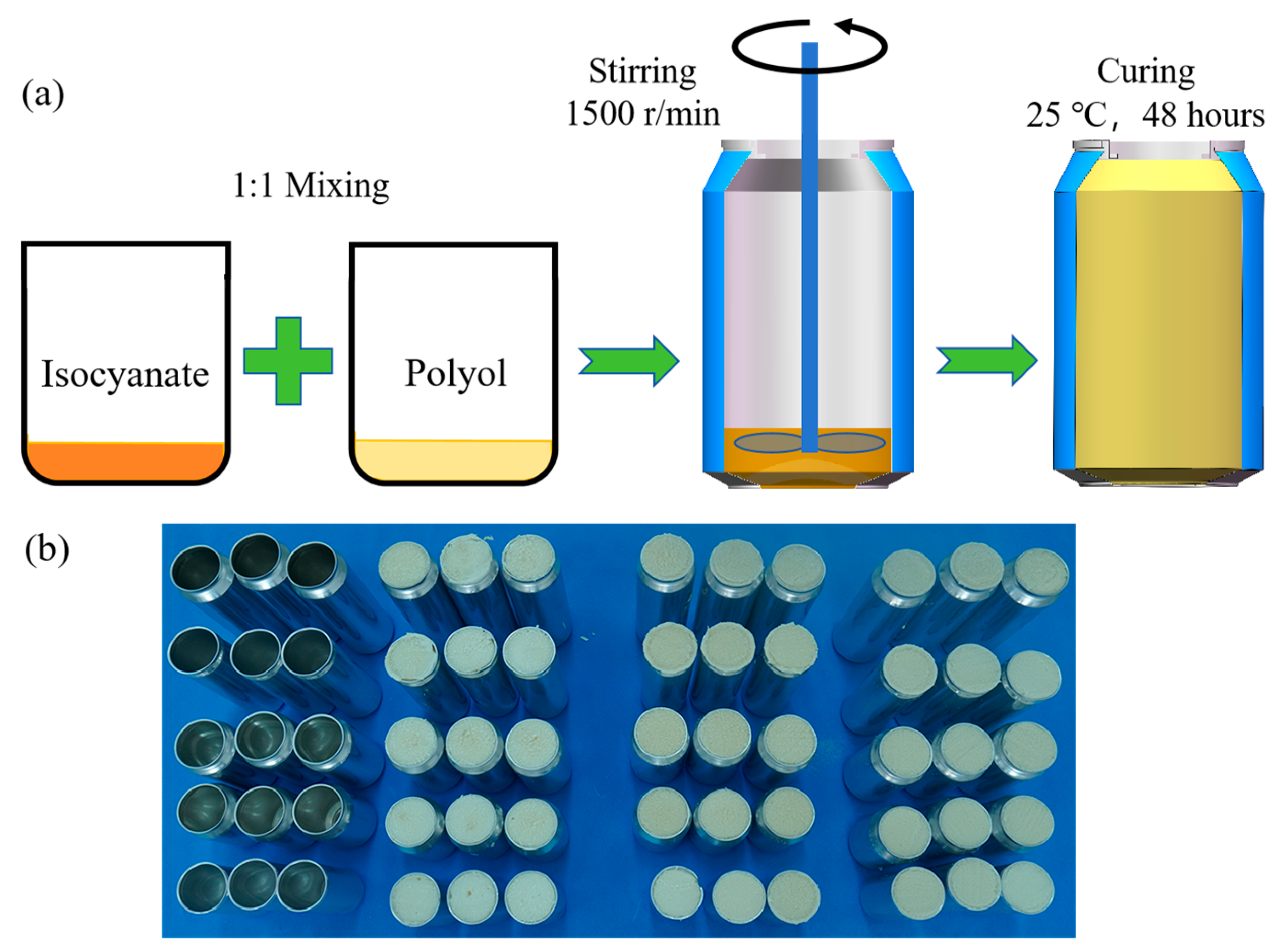
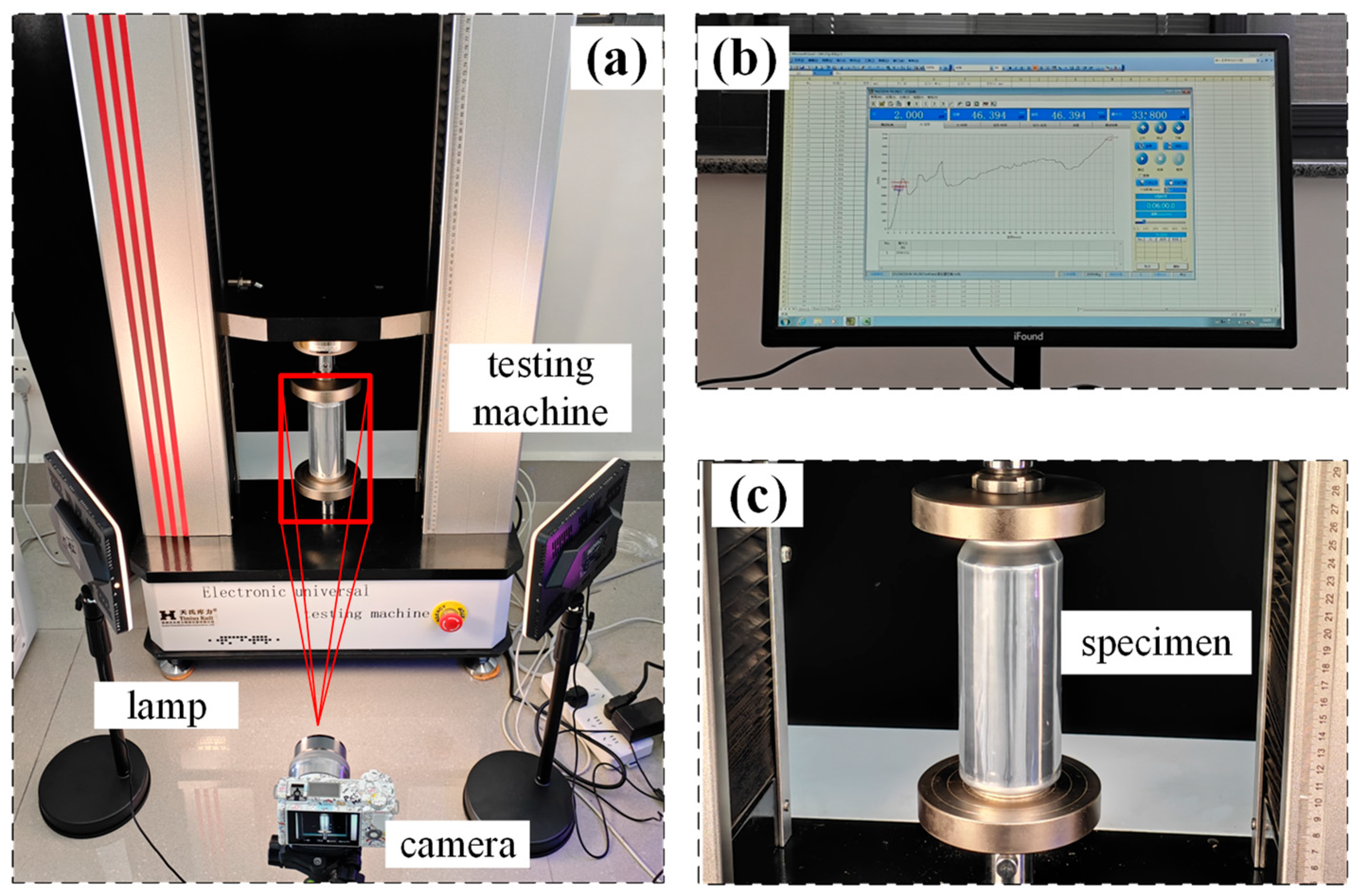
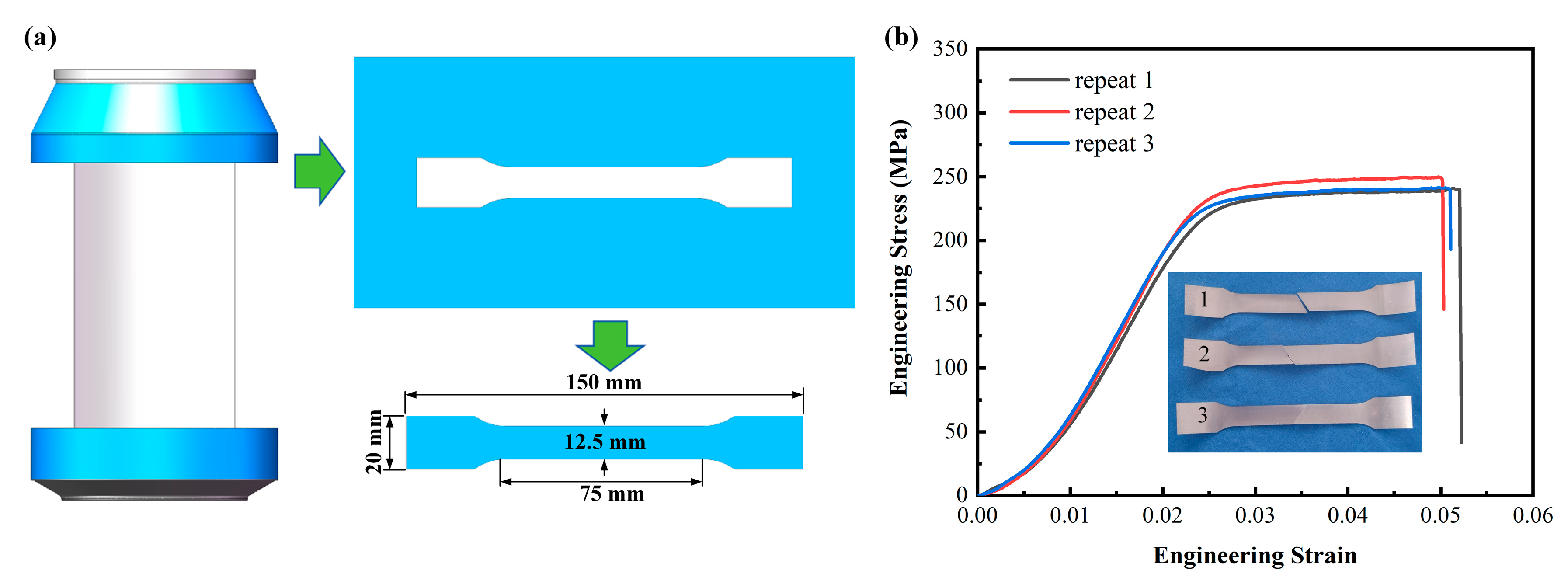

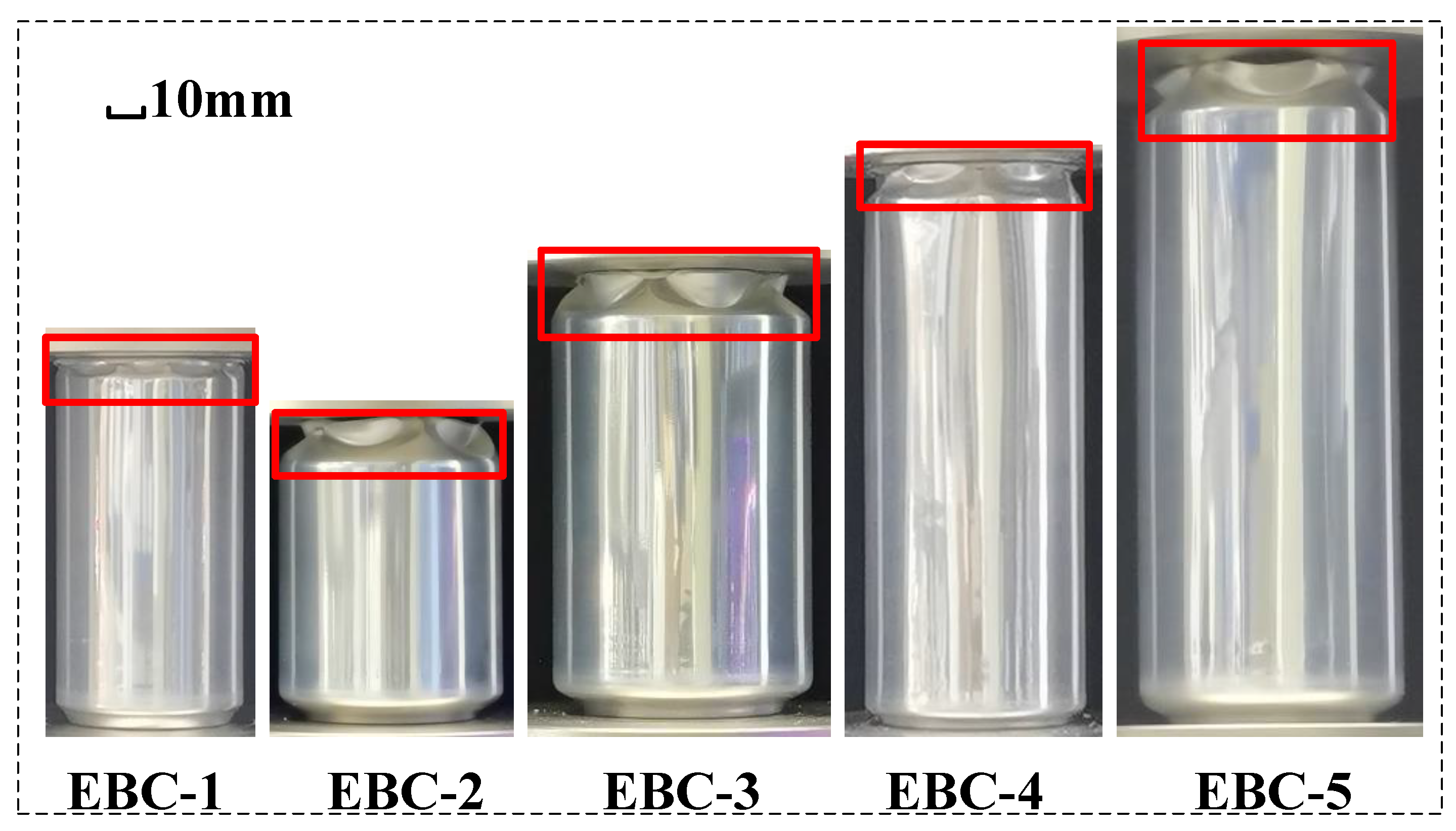
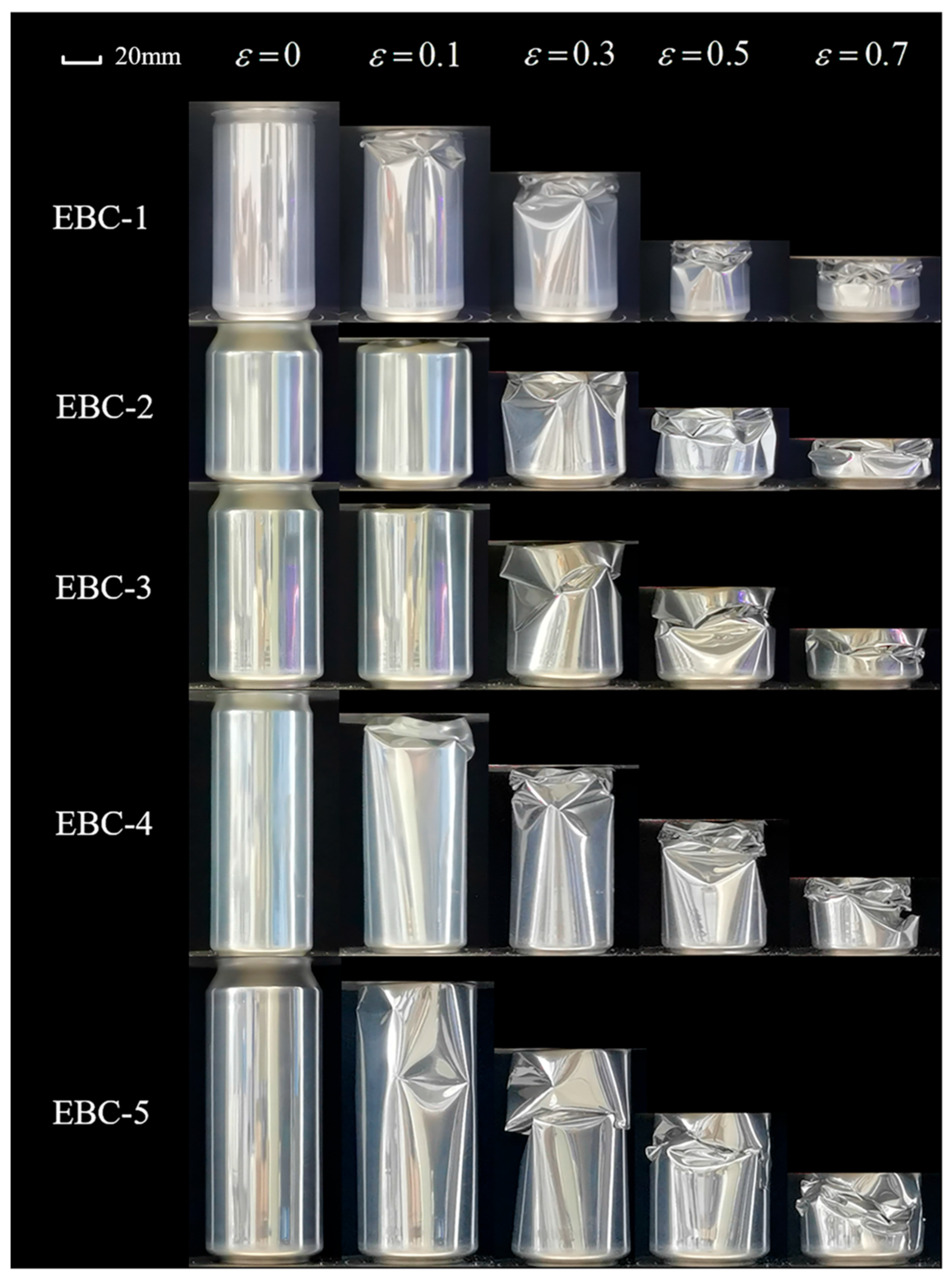
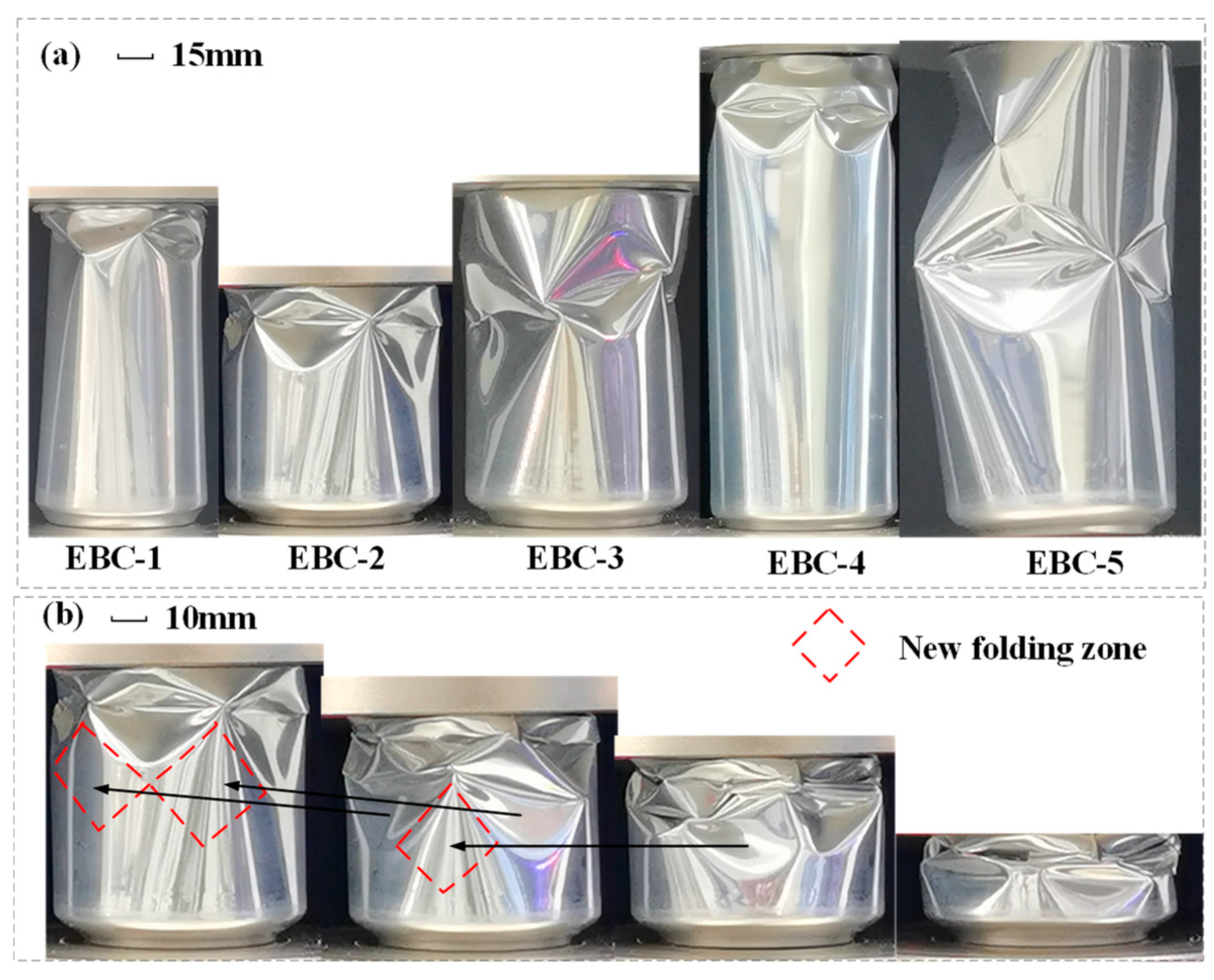
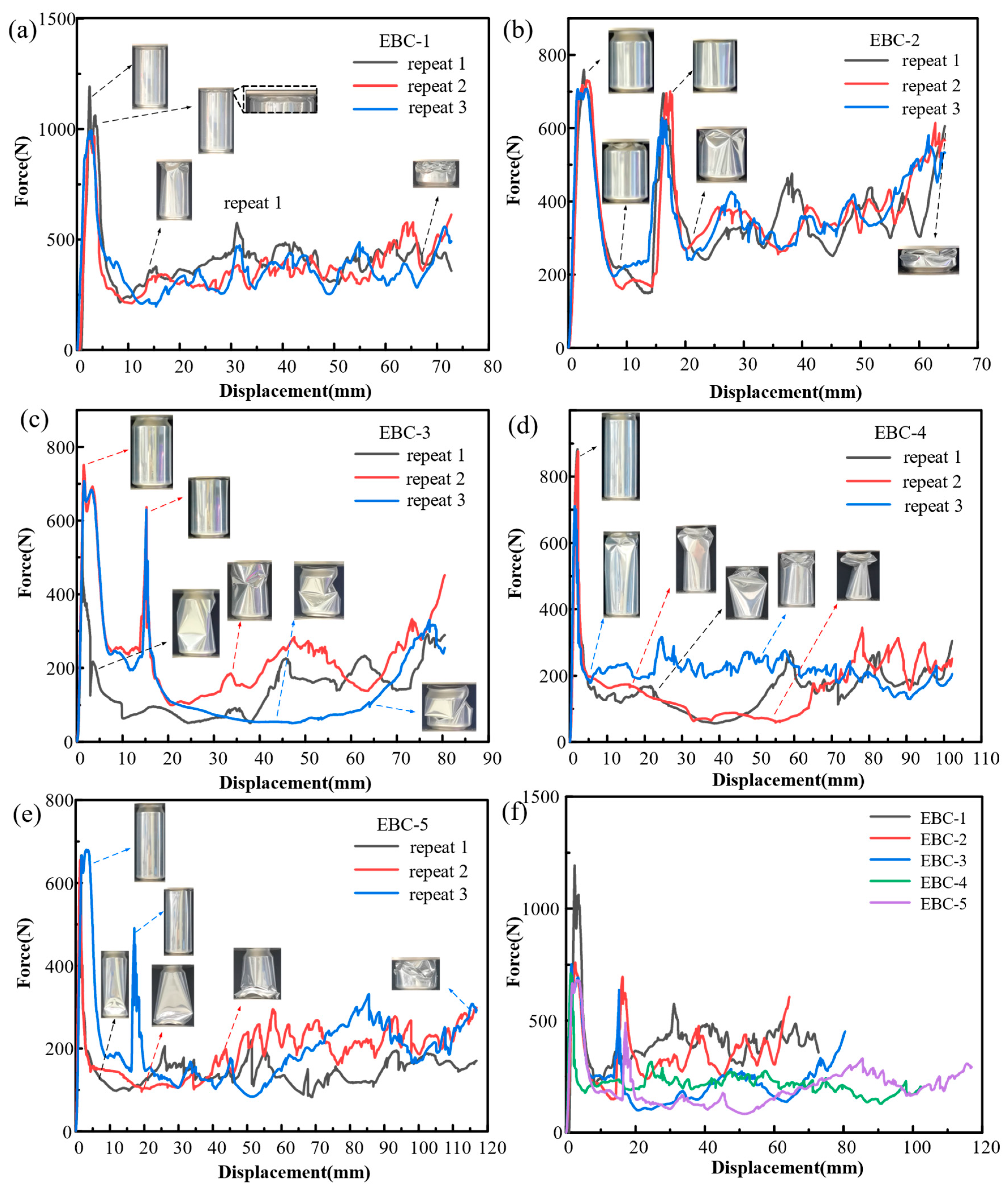

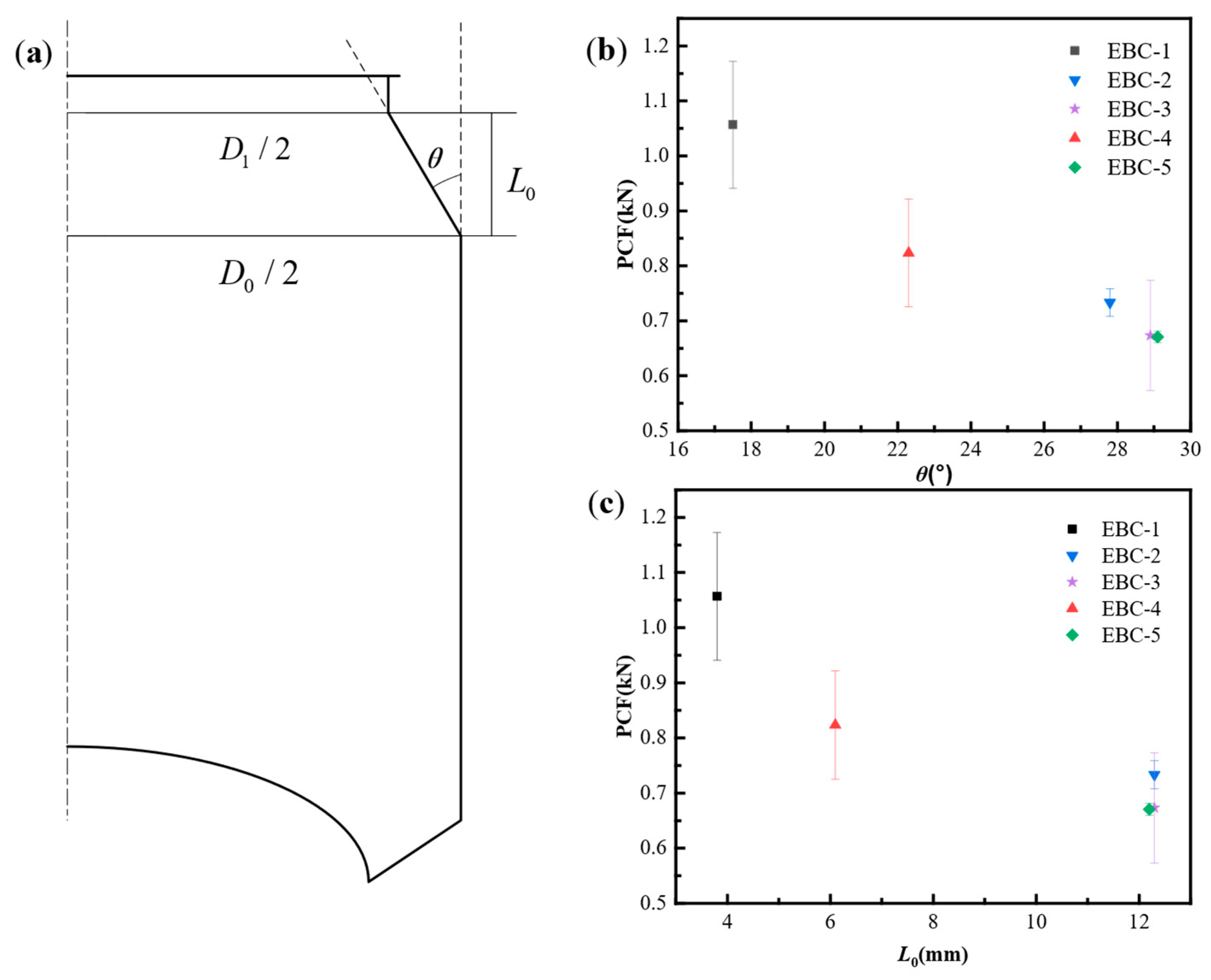

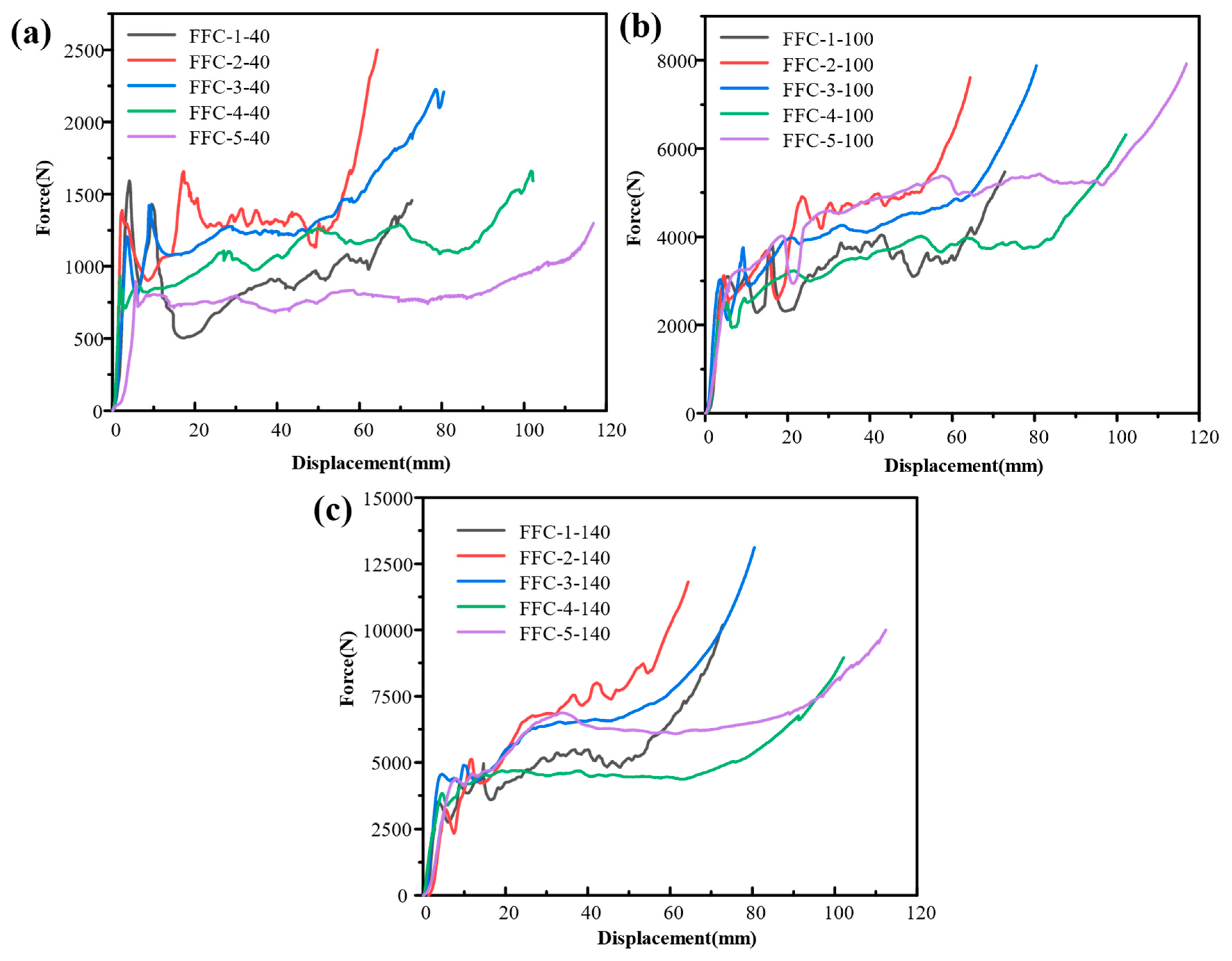
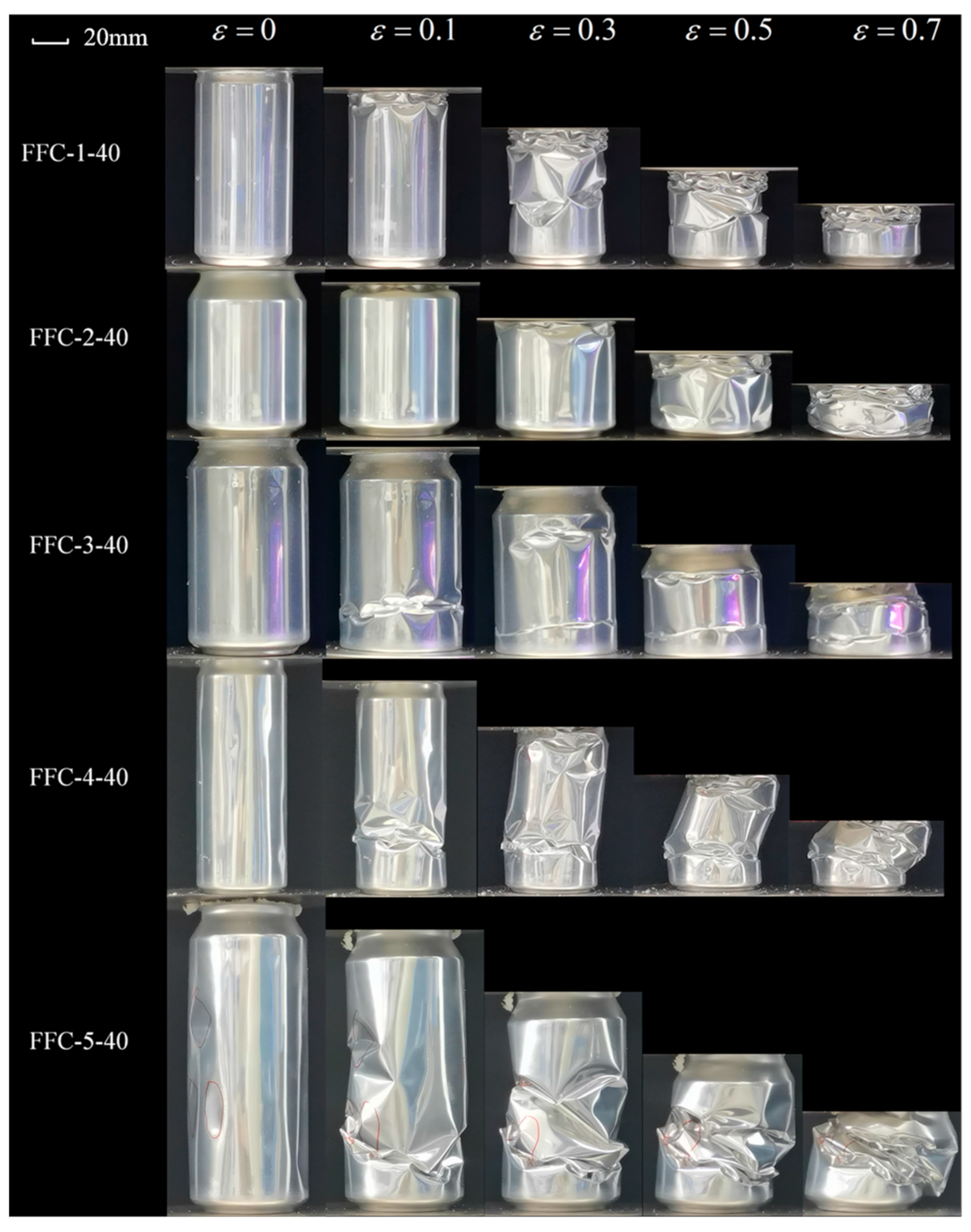
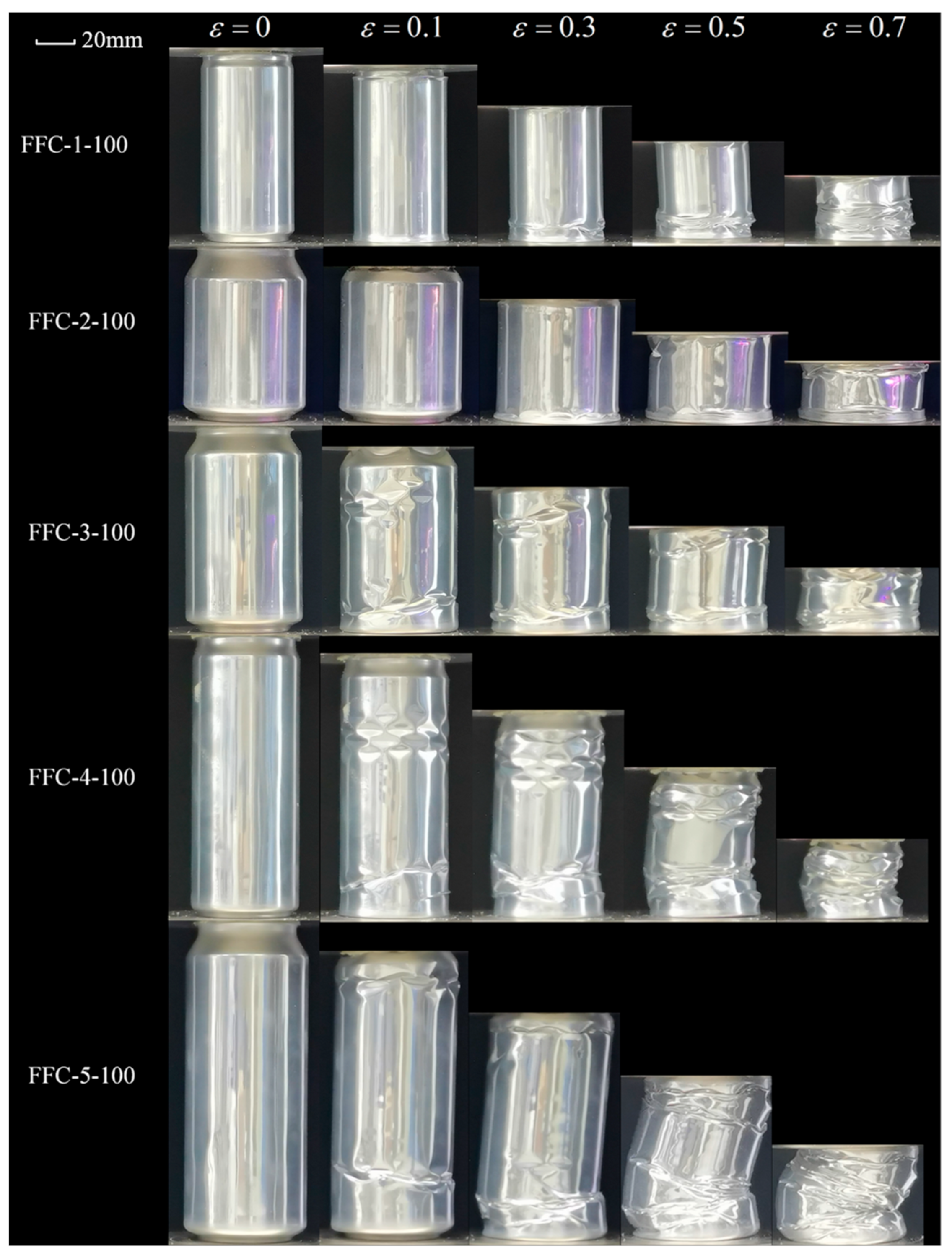
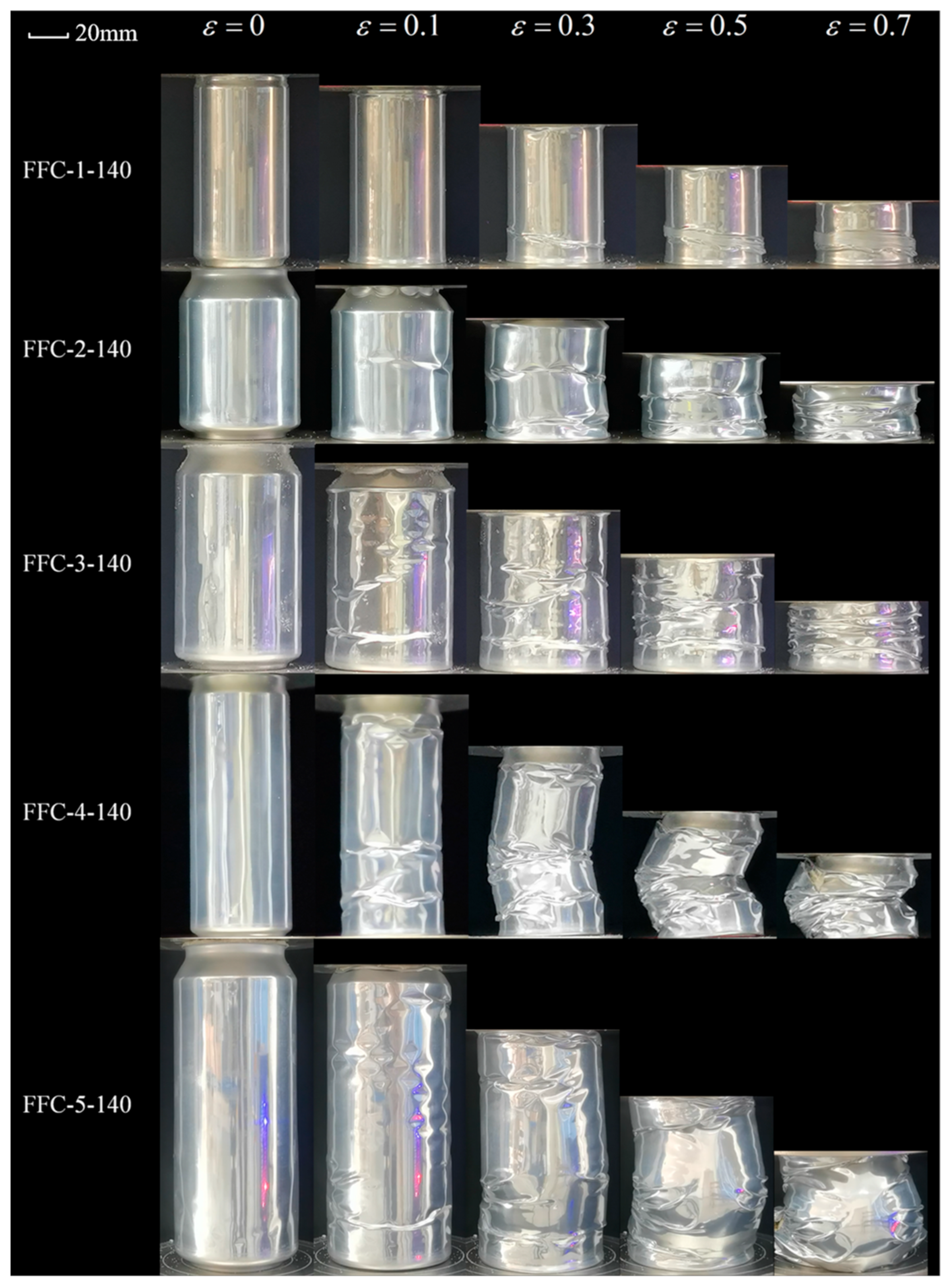

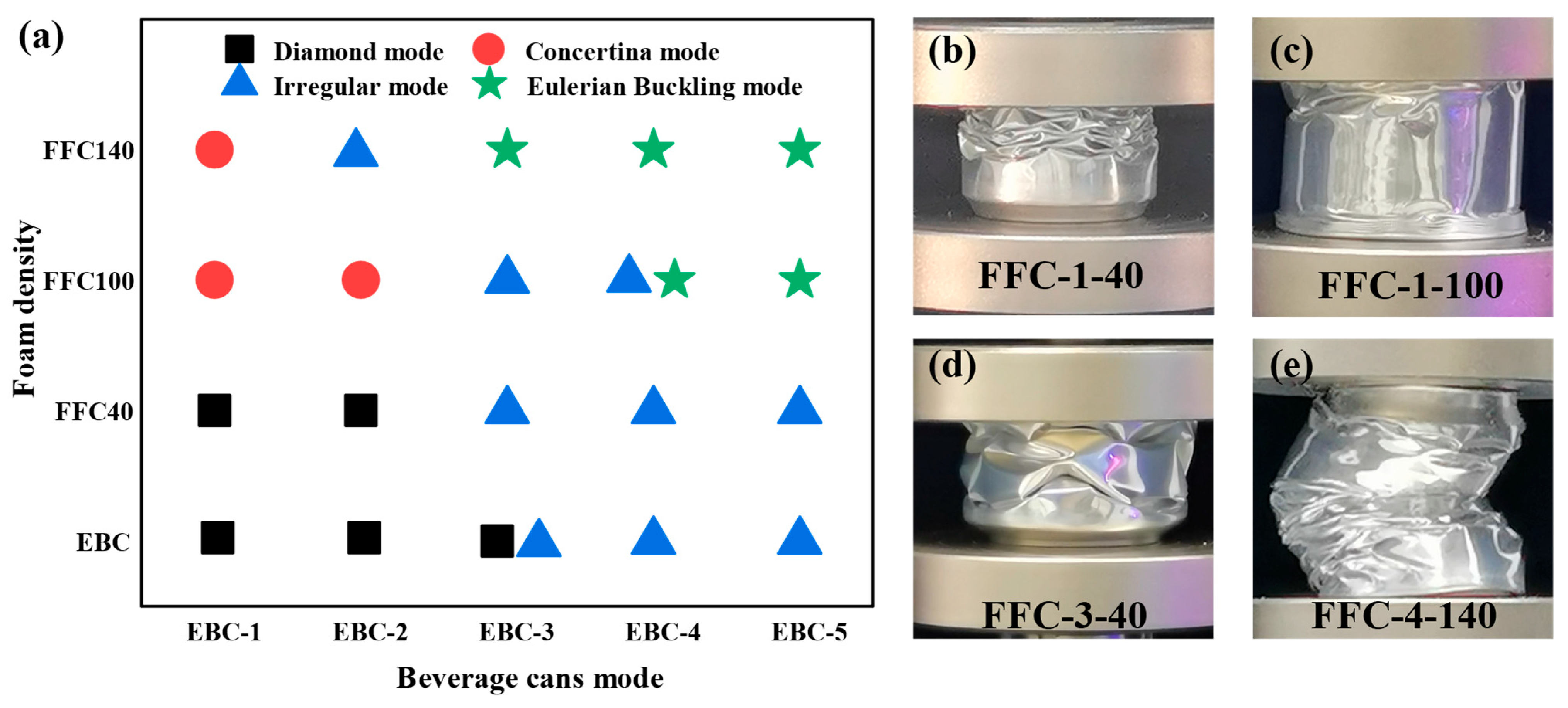



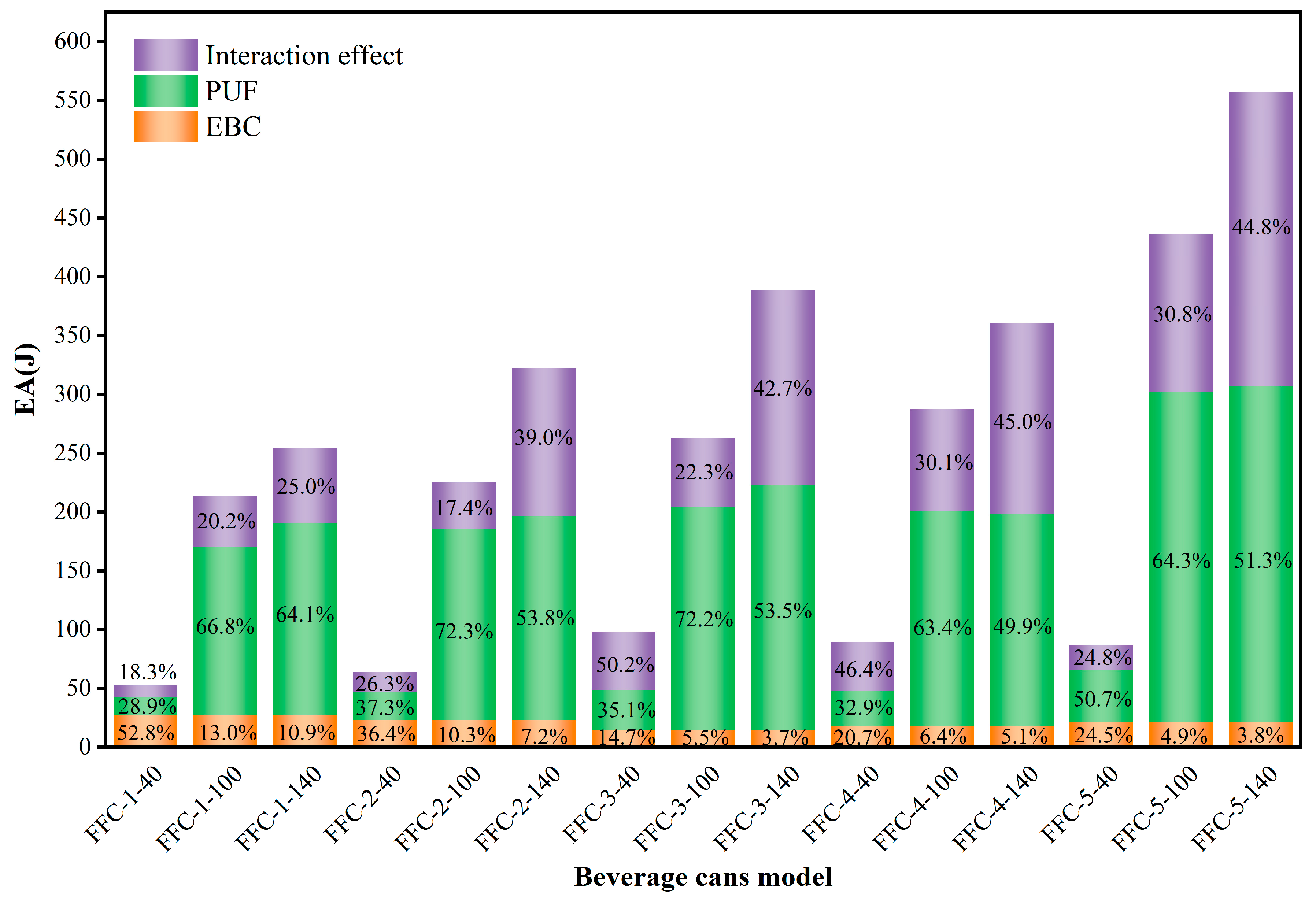
| Specimen | Capacity (mL) | D0 (mm) | T (mm) | H0 (mm) | H1 (mm) |
|---|---|---|---|---|---|
| EBC-1 | 190 | 53 | 0.153 | 104 | 93 |
| EBC-2 | 250 | 66 | 0.134 | 92 | 69 |
| EBC-3 | 330 | 66 | 0.112 | 115 | 93 |
| EBC-4 | 330 | 57 | 0.118 | 146 | 130 |
| EBC-5 | 500 | 66 | 0.116 | 167 | 143 |
| Specimen | L0 (mm) | D1 (mm) | D0 (mm) | (°) |
|---|---|---|---|---|
| EBC-1 | 3.8 | 50.6 | 53.0 | 17.5 |
| EBC-2 | 12.3 | 53.0 | 66.0 | 27.8 |
| EBC-3 | 12.3 | 52.4 | 66.0 | 28.9 |
| EBC-4 | 6.1 | 52.0 | 57.0 | 22.3 |
| EBC-5 | 12.2 | 52.4 | 66.0 | 29.1 |
Disclaimer/Publisher’s Note: The statements, opinions and data contained in all publications are solely those of the individual author(s) and contributor(s) and not of MDPI and/or the editor(s). MDPI and/or the editor(s) disclaim responsibility for any injury to people or property resulting from any ideas, methods, instructions or products referred to in the content. |
© 2024 by the authors. Licensee MDPI, Basel, Switzerland. This article is an open access article distributed under the terms and conditions of the Creative Commons Attribution (CC BY) license (https://creativecommons.org/licenses/by/4.0/).
Share and Cite
Wang, Z.; Liu, Z.; Liu, Y.; Ma, W.; Zhang, Z.; Zhao, C.; Yang, C. On the Crush Behavior and Energy Absorption of Sustainable Beverage Cans and Their Polyurethane Foam-Filled Structures: An Experimental Study. Materials 2024, 17, 2655. https://doi.org/10.3390/ma17112655
Wang Z, Liu Z, Liu Y, Ma W, Zhang Z, Zhao C, Yang C. On the Crush Behavior and Energy Absorption of Sustainable Beverage Cans and Their Polyurethane Foam-Filled Structures: An Experimental Study. Materials. 2024; 17(11):2655. https://doi.org/10.3390/ma17112655
Chicago/Turabian StyleWang, Zelin, Zheng Liu, Yangzuo Liu, Wuning Ma, Zhendong Zhang, Changfang Zhao, and Chunhao Yang. 2024. "On the Crush Behavior and Energy Absorption of Sustainable Beverage Cans and Their Polyurethane Foam-Filled Structures: An Experimental Study" Materials 17, no. 11: 2655. https://doi.org/10.3390/ma17112655







